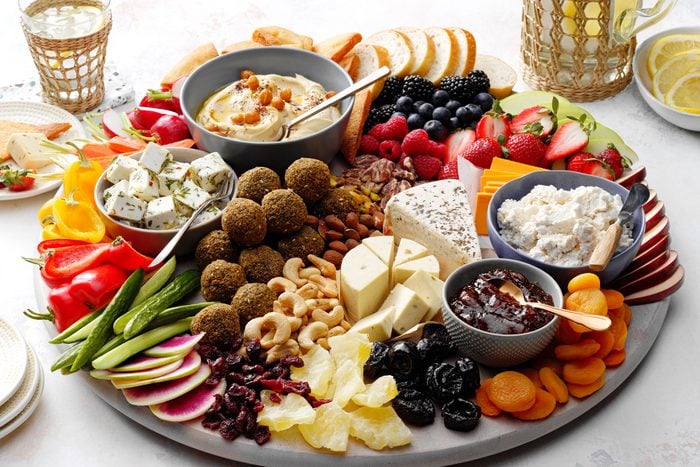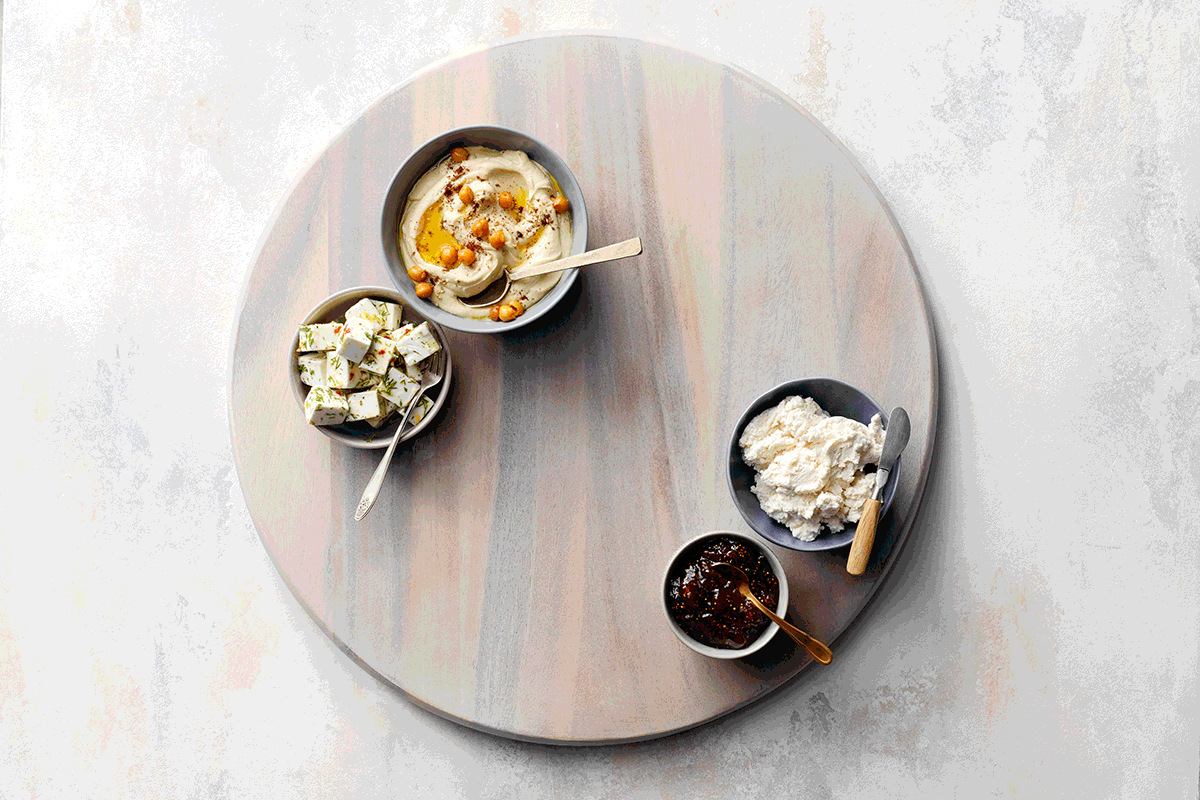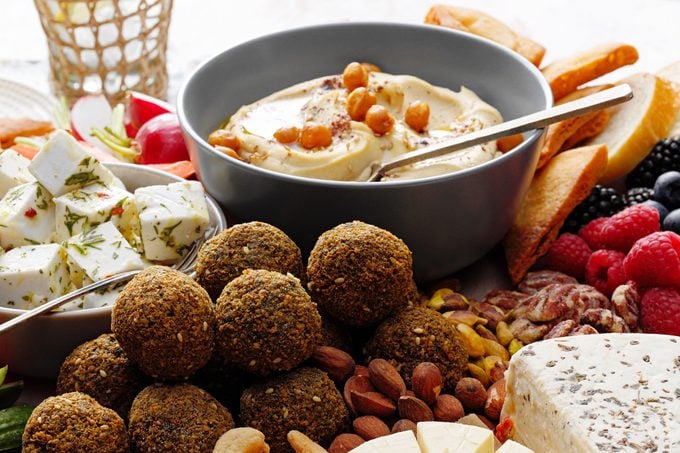How to Make a Vegan Charcuterie Board
Updated: Jan. 24, 2023

Salty, zesty, sweet and crunchy—we made the perfect vegan charcuterie board. Here's how to build a plant-based snack board for your next party.
Being vegan doesn’t mean you have to miss out on the fun and deliciousness of charcuterie boards. Whether you’re hosting a party where you need healthy vegan snacks or having a solo wine night, we’ll teach you how to build a vegan charcuterie board with a rich variety of flavors, textures and colors that will even impress meat-lovers.
What Is a Charcuterie Board?
The original meaning of the French word charcuterie (pronounced “shar-koo-tur-ee”) was a pork butcher’s shop or a shop that sold cured meats such as bacon, salami or prosciutto.
Europeans have been eating charcuterie along with cheeses, bread, fruits, vegetables and ales for hundreds of years, and this practice evolved into the charcuterie board we know and love today. With its stylish arrangement of bite-sized food served on seriously beautiful wooden or stone platters, it’s the perfect hors d’oeuvre for grazing.
Nowadays, there are so many versions of charcuterie boards, from cozy hot chocolate boards to butter boards going viral on TikTok and Instagram.
Luckily, it’s no different if you’re vegan! Jump on the trend and make a beautiful vegan snack board with veggies, fruit, spreads and plant-based cheeses and meats to accompany your wine. While you can’t go wrong with your own customizations, there’s definitely an art to it, so we’ve got you covered with our tips and tricks.
How to Build a Vegan Charcuterie Board
Foods to Include
Vegan cheeses: These days, most large supermarkets stock plant-based cheeses, and they seem to be getting closer to the real thing. We started with marinated vegan feta: Cube the vegan feta and toss it in a mix of olive oil, lemon zest, fresh lemon juice, chopped fresh dill and parsley, crushed red pepper flakes, salt and pepper.
We also used vegan ricotta, vegan mozzarella (in a wedge), vegan jalapeno Havarti (a round cut into wedges) and vegan medium cheddar.
Vegetables: Veggies may be the most obvious ingredient for a vegan charcuterie board, but it’s important to select the right ones so that they’re appealing raw. Think bigger than baby carrots and celery (although those are certainly delicious), and add red radishes for a peppery crunch, refreshing sliced cucumbers, crisp red peppers and sugar snap peas.
Spreads: Let’s be honest—those vegetables are nice, but they’re even better as vehicles for sauces and spreads. Every great charcuterie board has a variety of spreads, like honey and jam, to bring extra layers of flavor to the table. Making homemade hummus to dip your veggies is delicious, affordable and ridiculously easy. We topped ours with olive oil, roasted chickpeas, toasted sesame seeds and sumac.
And while fig jam may sound more like dessert than an appetizer spread, the sweetness actually counterbalances the savoriness of other ingredients like vegan cheese.
Olives or pickled vegetables: Olives are a must for charcuterie boards, whether you choose Greek kalamata olives or Italian marinated olives. Hate olives? Substitute with cute cornichons or pickled daikon radish and carrots for a punch of briny vinegar to make your taste buds dance.
Falafel: A slightly more unconventional addition to our vegan board is falafel, a Middle Eastern dish made from dried chickpeas that are ground with fresh herbs, rolled into balls and deep-fried. Full of fiber and protein, falafel will make your vegan charcuterie board more robust and irresistible. Fry your own falafel at home so that you can tweak the spices and serve them while they’re still delightfully crispy.
Fruit: Pretty much any fruit in your fridge will do, but try to opt for less messy and less watery fruits that won’t leak all over the board. Sliced Bosc pears, Granny Smith apples and Red Delicious apples pair beautifully with fig jam, while grapes, blackberries, strawberries, blueberries and raspberries add a tart sweetness. Dried apricots, prunes, cranberries and pineapple add fiber and chewiness that’s even easier to pop into your mouth.
Bread and crackers: Traditional charcuterie boards often feature slices of crusty bread like baguettes, but we also love Mediterranean pita bread and airy crackers for a lighter carb. Pita and hummus are a match made in heaven, and you can easily smear the crackers with feta or ricotta and top with fruit. When buying crackers, make sure butter or other dairy products haven’t snuck into the ingredient list. You can also make your own crackers from scratch using vegan butter!
Assorted nuts: To top it all off, add an extra dash of protein and crunch with cashews, pistachios, almonds, walnuts and hazelnuts. You can get creative with flavors and roast them with chili and cayenne pepper, or go for garlic and onion cashews.
Directions

What separates good charcuterie boards from truly amazing, photo-ready centerpieces is the arrangement. You want to get a board big enough for the ingredients (but not so big that the board looks sparse) and layer bite-sized pieces that are easy to pick up.
Create a visual narrative by pairing ingredients and placing different colors and shapes throughout the board so it feels both elegant and effortless.
Step 1: Arrange small bowls on the board
Spreads, olives, soft cheeses and anything else that may get a little messy should go into bowls. You can place the ricotta, jam and olives on the lower right and hummus and feta cubes on the upper left so the bowls are grouped together in different parts of the board.
Step 2: Place the falafel and cheeses
Set the falafel balls near the hummus. Place the vegan mozzarella, vegan jalapeno Havarti and vegan cheddar near the bowls on the lower right.
Think outside the box when it comes to cheeses: Make your own shapes out of regular old cheese blocks by cutting them with shaped cookie cutters. We used a round cutter for the Havarti here, then cut the round into wedges.
Step 3: Add dried fruit, fresh fruit and nuts
Stack your apple or pear slices in the right corner around the bowls. Then, place a mixture of berries near those slices so you have bright reds juxtaposed against dark blues. Dried fruit can be arranged in neat piles below the fresh fruit and nuts can be placed down the center of the board near the falafel. The nuts will help separate the fruits from the vegetables.
Step 4: Mix in some vegetables
Fan cucumbers, thin slices of watermelon radish, halved and quartered red radishes, mini bell peppers, and carrots in rainbow clusters around the bowls on the left portion of the board. These veggies pair well with the hummus and feta—placing them near each other will signal their compatibility to guests grazing this board.
Step 5: Add pita and crackers
Cut the pita into triangular slices and fan them out above the hummus and fruit. (We fried ours to make pita chips, which works well, too!). In the remaining space, pile crackers or baguettes slices. Sprinkle in more nuts and radishes to fill any empty spaces and bring the whole board together visually.
Step 6: Serve and enjoy
Put small serving spoons in the bowls and set small plates and plenty of napkins next to your finished vegan charcuterie board. Your guests will likely go back for more, so refill any sections that are running low throughout the night.
Tips for Making a Vegan Charcuterie Board

What kinds of vegan cheeses can you use for a vegan charcuterie board?
When it comes to classic charcuterie boards and cheese board pairings, a good rule is to include a mix of hard and soft cheeses. Fortunately, there are more and more vegan versions of cheese out there—but you may need to shop at a specialty store if your regular supermarket doesn’t carry a variety.
Of course, not all vegan brands are equal, and you don’t want to get stuck with a whole package of less-than-stellar cheese. To find the flavors and textures you like best, ask if the store offers samples, and check out our recommendations for the best vegan cheese brands. (Just make sure to ask your guests if they have a nut allergy, as vegan cheese is sometimes made from cashews or almonds.)
For our vegan charcuterie board, we used vegan ricotta, marinated vegan feta, vegan mozzarella, vegan Havarti and vegan cheddar.
What kinds of vegan meats can you use for a vegan charcuterie board?
While some vegans aim for less-processed foods, vegan brands are also putting out some incredible vegan meat options that are perfect for charcuterie boards, such as Field Roast’s vegan pepperoni and Tofurky’s delicious deli meat slices.
If you’re iffy about long lists of ingredients and want to reduce buying things with plastic packaging, make your own mushroom jerky from scratch for the ultimate umami-packed snack.
Why stop at charcuterie boards? All kinds of boards can be made vegan with simple swaps. Here are some of our favorite vegan recipes to get you started.
